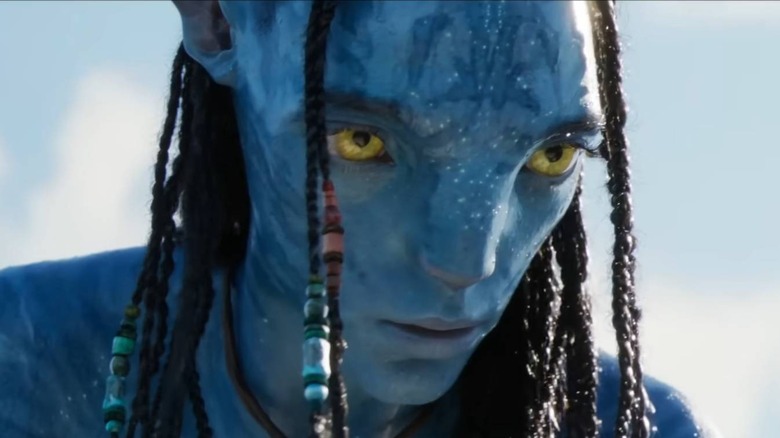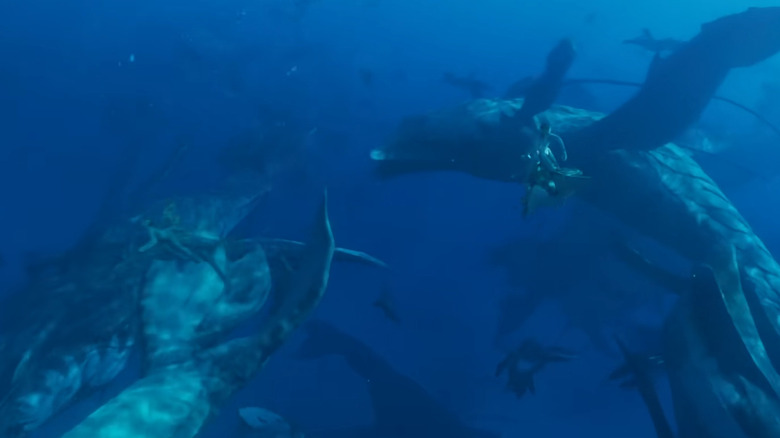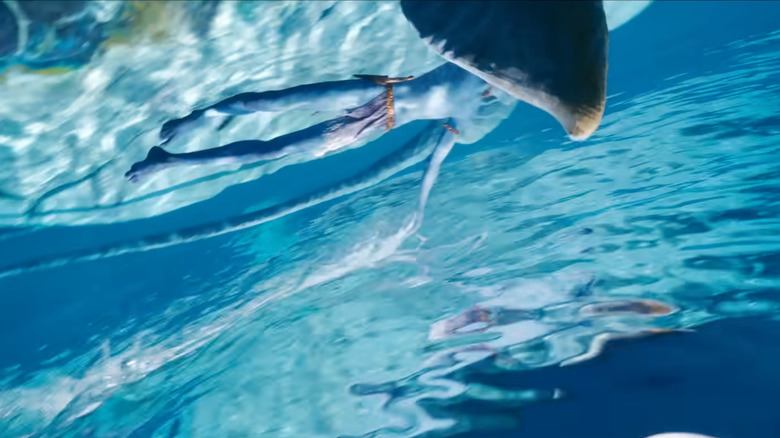The Avatar: The Way Of Water Scene That Went Too Far
The following contains spoilers for "Avatar: The Way of Water."
Upon watching "Avatar" for the first time, the theme immediately makes itself clear. The story may be about blue people trying to protect a tree from humans, but at its core, it's a tale of colonization and how humanity will wipe nature off the map if it means turning a profit. The ecological themes are pertinent throughout the story, and director James Cameron doubles down on environmentalism for the follow-up.
This time around, in "Avatar: The Way of Water," Jake Sully (Sam Worthington) and his family are freedom fighters, desperately trying to get the Sky People off of their land. However, once Jake's family puts itself in danger and he realizes he has a target on his back from a newly reborn Colonel Quaritch (Stephen Lang), they decide to travel to the Metkayina clan to hide and make new lives for themselves. While the first film was all about the forest, this time, we get a glimpse of a more coast-based biome where beings live in harmony on the reef. Of course, that harmony is quickly upended once humans and the villainous avatars make themselves known.
Humanity still hasn't learned its lesson to let nature be on Pandora, and there's one particularly gruesome scene that really drives that point home.
The murder of the tulkun was hard to watch
Humanity once again functions as a parasite on the back of Pandora. They've established a new base of operations, which involves regularly sending out a battleship to meet its quota. What's that quota, you ask? You're going to regret asking that.
In an extended sequence, humans deploy a variety of methods to subdue a tulkun, which is an incredibly intelligent whale-like creature that's able to communicate with the Metkayina clan. The tulkun also share an appreciation of music and mathematics, so it's clear these aren't just mindless animals swimming about. Still, thanks to a rare substance hidden within the tulkun that prevents human aging, it makes them a high-value target to less-than-scrupulous individuals.
We see just how corrupt and horrific mankind can be during a scene where they hunt a tulkun to death. And to make the scene even more heartbreaking, the tulkun's calf remains by its deceased parent's side as the humans begin preparations to bring the creature onboard to extract the valuable material. It's the equivalent of watching the killing of a whale and then having to see its captors drill into its skull. And naturally, things go from bad to worse quickly.
The calf dies, too
Later, the Metkayina clan, as well as the Sully family, visit the deceased tulkun, which was left in the ocean to function as a kind of message to any of the Na'vi who might think of crossing the humans. On top of that, the tulkun's calf is now dead, adding further heartbreak to the story.
On the one hand, it's understandable why this sequence was necessary for the film. It shows the callous cruelty of humanity, which sees no problem in killing innocent creatures just so a few rich jerks can prevent some wrinkles from forming. Plus, it makes it all the more satisfying to watch the humans on the ship get the ever-loving crud beaten out of them by the Na'vi and Payakan later, especially when it comes to the death of Captain Mick Scoresby (Brendan Cowell), who gets his arm taken off for good measure.
But in the moment, it's hard not to feel a similar grief to what Ronal (Kate Winslet) experiences. Throughout the film, we learn about the tulkun way and how emotionally intelligent these creatures are. To see them die in front of us is hard to watch, but James Cameron does have a knack for pulling at viewers' heartstrings.


